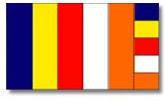Buddhist Studies:
Symbols/Iconography
The Buddhist Flag
The Buddhist flag is a modern creation it was jointly designed by Mr J.R. de Silva and Colonel Henry S. Olcott to mark the revival of Buddhism in Ceylon in 1880. It was accepted as the International Buddhist Flag by the 1952 World Buddhist Congress.
Colonel Olcott designed a flag from the six colours of the aura that he believed shone around the head of the Buddha after His Enlightenment.
The first five stripes of the flag are of five colours.

Blue | Universal Compassion | |
Yellow | The Middle Path | |
Red | Blessings | |
White | Purity and Liberation | |
Orange | Wisdom | |
The sixth colour is a conglomeration of the five, but for the design, it has been separated into its constituent colours.
The colonel’s flag later came to symbolize the unity of Buddhists. Thereafter, it has been used worldwide and has been used in nearly 60 countries during Buddhist festive seasons, particularly during the Vesak celebrations.
Colonel Olcott was one of the greatest American Buddhists who dedicated his later life entirely to the people of Asia. He is known as the father of the Buddhist education movement since he initiated the establishment of close to 400 Buddhist schools and colleges in Sri Lanka.

